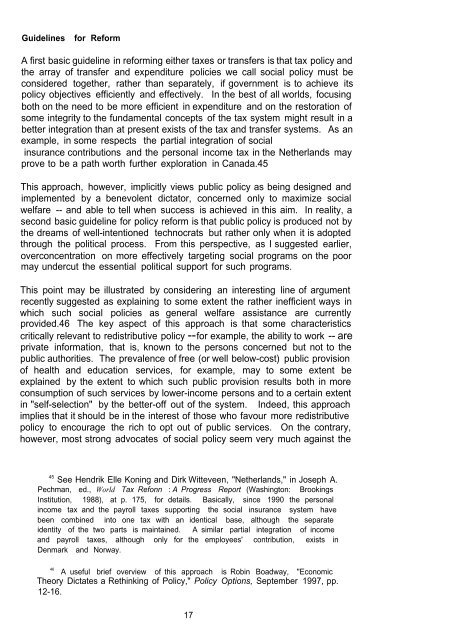Richard Bird - Institute for Public Economics - University of Alberta
Richard Bird - Institute for Public Economics - University of Alberta
Richard Bird - Institute for Public Economics - University of Alberta
Create successful ePaper yourself
Turn your PDF publications into a flip-book with our unique Google optimized e-Paper software.
Guidelines<strong>for</strong> Re<strong>for</strong>mA first basic guideline in re<strong>for</strong>ming either taxes or transfers is that tax policy andthe array <strong>of</strong> transfer and expenditure policies we call social policy must beconsidered together, rather than separately, if government is to achieve itspolicy objectives efficiently and effectively. In the best <strong>of</strong> all worlds, focusingboth on the need to be more efficient in expenditure and on the restoration <strong>of</strong>some integrity to the fundamental concepts <strong>of</strong> the tax system might result in abetter integration than at present exists <strong>of</strong> the tax and transfer systems. As anexample, in some respects the partial integration <strong>of</strong> socialinsurance contributions and the personal income tax in the Netherlands mayprove to be a path worth further exploration in Canada.45This approach, however, implicitly views public policy as being designed andimplemented by a benevolent dictator, concerned only to maximize socialwelfare -- and able to tell when success is achieved in this aim. In reality, asecond basic guideline <strong>for</strong> policy re<strong>for</strong>m is that public policy is produced not bythe dreams <strong>of</strong> well-intentioned technocrats but rather only when it is adoptedthrough the political process. From this perspective, as I suggested earlier,overconcentration on more effectively targeting social programs on the poormay undercut the essential political support <strong>for</strong> such programs.This point may be illustrated by considering an interesting line <strong>of</strong> argumentrecently suggested as explaining to some extent the rather inefficient ways inwhich such social policies as general welfare assistance are currentlyprovided.46 The key aspect <strong>of</strong> this approach is that some characteristicscritically relevant to redistributive policy --<strong>for</strong> example, the ability to work -- areprivate in<strong>for</strong>mation, that is, known to the persons concerned but not to thepublic authorities. The prevalence <strong>of</strong> free (or well below-cost) public provision<strong>of</strong> health and education services, <strong>for</strong> example, may to some extent beexplained by the extent to which such public provision results both in moreconsumption <strong>of</strong> such services by lower-income persons and to a certain extentin "self-selection" by the better-<strong>of</strong>f out <strong>of</strong> the system. Indeed, this approachimplies that it should be in the interest <strong>of</strong> those who favour more redistributivepolicy to encourage the rich to opt out <strong>of</strong> public services. On the contrary,however, most strong advocates <strong>of</strong> social policy seem very much against the45See Hendrik Elle Koning and Dirk Witteveen, "Netherlands," in Joseph A.Pechman, ed., World Tax Refonn : A Progress Report (Washington: BrookingsInstitution, 1988), at p. 175, <strong>for</strong> details. Basically, since 1990 the personalincome tax and the payroll taxes supporting the social insurance system havebeen combined into one tax with an identical base, although the separateidentity <strong>of</strong> the two parts is maintained. A similar partial integration <strong>of</strong> incomeand payroll taxes, although only <strong>for</strong> the employees' contribution, exists inDenmark and Norway.46A useful brief overview <strong>of</strong> this approach is Robin Boadway, "EconomicTheory Dictates a Rethinking <strong>of</strong> Policy," Policy Options, September 1997, pp.12-16.17



